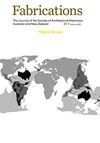An Antipodean Attica
IF 0.3
0 ARCHITECTURE
Fabrications-The Journal of the Society of Architectural Historians Australia and New Zealand
Pub Date : 2023-08-04
DOI:10.1080/10331867.2023.2240079
引用次数: 0
Abstract
ABSTRACT The Lady Franklin Museum at Ancanthe, near Hobart, is a pivotal building. It represents a conscious attempt by Jane Franklin to evoke Attica in Australia, an important essay in the Greek Revival by James Blackburn, and a key element in Hardy Wilson’s interpretation of classicism in Australia. In its conception and its realisation it was enmeshed with two other projects—the unrealised scheme for St John’s College, New Norfolk, and the realised but mauled portico on the Government Offices in Hobart. All three were involved in the conflict between Blackburn’s Greek Revival and the collegiate Gothic espoused by the incoming Colonial Architect W. P. Kay. Historically the Museum, which was first conceived as a “glyptothek” and then as a natural history museum, is a core element in the development of the Tasmanian Society of Natural History and its successor the Royal Society of Tasmania.澳大利亚的阿提卡
本文章由计算机程序翻译,如有差异,请以英文原文为准。
求助全文
约1分钟内获得全文
求助全文
来源期刊

CiteScore
0.50
自引率
25.00%
发文量
26
 求助内容:
求助内容: 应助结果提醒方式:
应助结果提醒方式:


